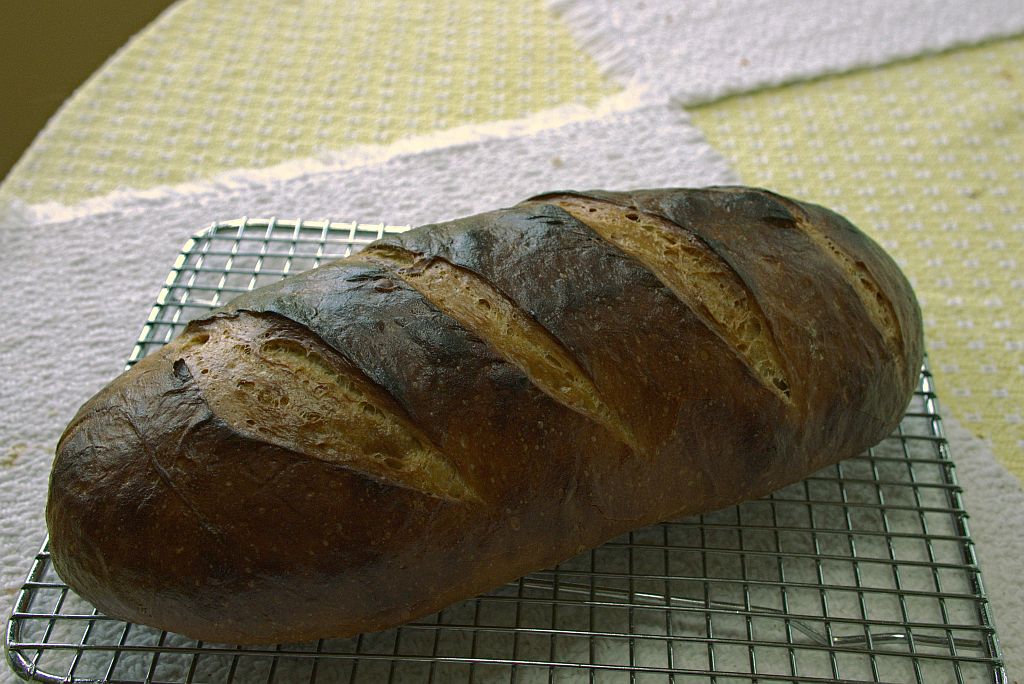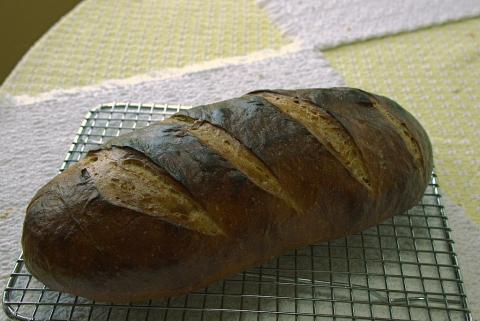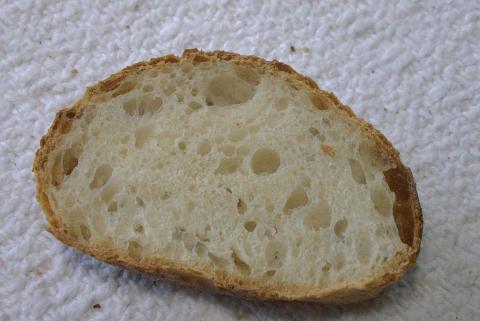
Don't Sweat The Starter

In a recent thread (https://www.thefreshloaf.com/node/72744/how-much-feed-starter-recipe#comment-524154), I wrote:
You know what? If you see a recipe that asks for a white flour starter but you only have say a 50-50 mix of whole grain and white in your starter, just go ahead and use your starter. And the reverse as well. If a recipe says to use a starter with 80% hydration but yours is 100%, just use yours and reduce the total water in the recipe by a tiny amount to make up for the increased water in your starter.
If you have a nice active starter, you are going to get good bread.
Now if you get into rye-heavy sour breads this advice isn't going to be as successful, but for mostly-wheat breads, no problem.
The context is that the original poster had been asking a lot of detailed questions about feeding a new starter, when or whether it should be converted from partially rye to all white, and so on. This is a person new to sourdough baking, so it's no surprise she would like guidance.
I had been posting that most of these details are not important in the overall scheme of things, as long as the newly created starter is rising and vigorous. I had also posted on a related thread that exact details of hydration, flour composition, etc. also aren't terribly important in most cases.
So I thought I would demonstrate some of my claims. I'm posting this in case it is interesting or helpful to someone. I started the dough last night and finished baking this morning. Here's what I did.
Starter
----------
I took 1 oz of my regular all-purpose, 100% hydration starter from the refrigerator and refreshed it with 2 oz of flour and 2.5 oz of water. Here's the twist - the flour was half AP and half masa harina (the lime-treated corn flour often used to make tortillas). Normally I would have used 2 oz of water, but I knew that the masa harina would absorb more. I aged this mix at room temperature (75 deg F/24C) for 6 hours until it had more than doubled and gone past peak volume. It was very active.
According to my claims, this starter should be perfectly good for baking despite its unusual composition.
Dough
----------
The dough was an simple standby recipe I like:
100% AP flour
65% water
2% salt
19% starter (normally I would use 20 - 30%)
The small amount of starter was designed to give me a 12-hour bulk ferment, which I like because it brings out a really good flavor.
Mix by hand, rest 1/2 hour, knead/stretch. Three S&Fs over the next 3 hours. Bulk ferment 12 hours at room temperature.
I used 10 oz of flour, enough to make a smallish, 1 pound loaf.
Shaping
------------
After such a long room-temperature fermentation, the dough was very extensible as you can imagine. It was also very gassy and felt almost like silk. I stretched it out and folded it over on itself gently, then made a round preshape which I let rest for around 15 minutes. I used almost no flour doing this.
Then I shaped a batarde making sure to get good tension but still being gentle.
Proof and Bake
----------------------
The loaf proofed free-standing for 75 minutes. It fooled me because when I tested it with a finger, the dent didn't relax back but after the bake the loaf looks a little underproofed. No worries, check the photo below to see the crumb.
The slash pattern is intended to allow the bread to rise upwards instead of sideways, which it succeeded in doing. With the extensibility and a bit of sideways flattening during proof, I wanted to give the loaf the best chance of producing good loft.
I baked in an oven preheated to 500 deg F/260C, with a baking steel. I used initial steam, reduced the temperature setting to 435 deg F/224C, and baked for 38 minutes. Final interior temperature was 210 deg F/99C.
Crust, Crumb, and Flavor
---------------------------------
The crust has a deep reddish-brown color and has a definite sheen. It has a medium thickness and is crispy to bite with a good flavor with no hint of burning or over-cooking. The crumb is pretty open for a 65% hydration bread. It is clean to bite through, not gummy or hard at all. The flavor is smooth and buttery with a tantalizing slightly sweet undertaste. It is not sour, as I have learned to expect with this starter and process. Overall, this is a bread I would be happy to have anytime.
So there you are - go ahead and play with your starters and times and don't obsess about the exact details.
Here are the photos -




My usual approach to maintaining my starter is to feed it a combination of whole wheat, whole rye, and AP or bread flours. Consequently, its color is usually a brownish shade.
Which breads do I use it in? All of them that need starter.
When I build a levain, I use whatever flour the formula calls for. The starter inoculation, then, becomes a relatively small percentage of the overall flour in the recipe. White breads will show a few flecks of bran from the whole wheat and whole rye flours in the starter but not enough have a significant effect of the color of the crumb in the finished bread.
The key, as you point out, is that the starter is active and capable of raising the dough. The selected process will have a larger influence on the bread's characteristics than will the small amount of starter.
Paul
It's non specific. Just a bit of the previous bake leftover to continue the process. A levain is a purposefully built "starter" that is now geared towards the recipe. A starter doesn't have to be built to the "correct" hydration nor flour. It is the levain where the recipe begins.
If I skip a levain build inevitably i'll use a small amount of starter that will come to about the same amount used to build a levain. Should I happen to have a large amount of starter, that has recently been fed and it's near enough built to the requirements of the final recipe then i'll up the percentage. If it hasn't been fed in a while or I don't have enough then i'll give it a feed which might as well be done with flour that suits the final bread i'm after.
In other words i'm very flexible and decisions are made depending on the outcome, time available, what I have in stock, when my starter was fed etc.
Should I be following a special recipe that I like and have the time i'll be more pedantic for that particular bake.
That is a fine looking loaf there tpassin.
Tom,
So much great information! I have been wondering about much of those things as I made three loafs this week, with improvements made each time.
I am getting ready to store my starter in the fridge and was wondering how much should I keep?
I am so leary about putting it in the cold refrigerator but I am trusting the science.
Also, in order to get a complex starter, do I need to keep my 2 week old starter out of the fridge? Will it develop better outside the fridge with two feedings daily? Can I go to one feeding?
I am still learning so much bit having so much enjoyment. And my 3rd loaf tasted pretty good! (I honestly had no clue what the scoring was for!)
PXL_20230818_225339164.jpg
Looking better and better, Kimberly.
As to the starter, if you were running a bakery you would probably refresh/rebuild your starter once a day or even twice a day. But most of us at home won't be baking a loaf or two every single day, unless we have very big families or a lot of bread-loving friends. You could refresh it every day, but that gets to be a drag pretty quickly. And you have to worry about what to do if you want to go away for a few days.
I'll tell you what I do with my starter and why. Then you will hear from other folks that they do something different. That's fine. Once again, the details don't matter all that much. What's important is that you work out a process that works for you, in your kitchen, with your kind of baking.
My go-to starter is a 100% white all-purpose, 100% hydration starter. I like 100% hydration because it's easy to mix and pull out a blob to use. Also it produces a nice mellow flavor which I like, especially in a white-ish bread. It has a disadvantage - it won't last as long without feeding as a lower hydration starter. I just live with that. I use AP instead of bread flour because sometimes I can't get bread flour (or I can only get a more expensive bread flour) , and otherwise I don't think it makes a difference. Oh, and an all-white starter is likely to need feedings less often than one that includes whole grains.
I don't want to refresh my starter every day, and actually, the way it develops on the counter I would need to refresh it more often than that. I store my starter in the refrigerator. Once I refresh it, I let it ferment on the counter (at around 72 - 76 deg F, my normal room temperature) until it gets very bubbly and has risen more or less by two. You know what I mean by "very bubbly" because your starter got that way a few days ago. It usually takes around 5 to 6 hours to get to this state. The exact amount of rise and bubbles isn't important. If it gets to a maximum rise and starts to fall, that's OK too.
At this point, I consider the starter ready to use to make bread dough, or a levain. If I'm going to bake, I take out what I need, usually 2 - 4 ounces. Then I put the rest in the fridge. It will be good to use for making bread for probably three more days (that can vary).
Longer than that, I *may* be able to use it but the bread will probably ferment slower (and you may notice a slightly different flavor). But you have to check it out first. The main thing to look for is that if the starter has become noticeably thinner - it won't have the body and cohesiveness that it had originally - in the worst case it will get thin like soup - then refresh it before use.
If I were to use the starter at the three-day period, after mixing the dough I would discard excess starter and feed it again. Of course, if you use some starter and don't have much left, feed it so that you end up with a good amount again.
You can keep this starter for a week or even two without feeding, It's not a disaster but you will have to feed it at least once and maybe twice before it's fit to use again.
If you don't refrigerate the starter at all, you will find that it gets thin or soupy much faster so you will need to feed it much more often.
How much to feed and how much to keep?
I normally feed 3 oz (90g) each of flour and water. That gives me 6 oz of starter plus whatever was in the container when I started, certainly an ounce and often two. Since I usually use 2 - 3 oz for a bake, I can get two bakes per feeding if I want. This amount is perfect for a 1-quart/liter container. It will rise most of the way without overflowing. And that size container fits in the refrigerator easily.
Of course, you want to keep the starter container covered. And don't use a screwtop or clamped lid, since the starter will continue to ferment slowly in the fridge and you want to let the gas escape.
As the starter ages in the fridge, it will probably develop a stronger or more complex aroma. This is nice but won't necessarily carry over to the bread. If it does, so much the better.
You asked "Also, in order to get a complex starter, do I need to keep my 2 week old starter out of the fridge?" No; in fact it will probably get more complex in the fridge than outside.
If and when you get interested in making more sour bread, or in making rye-heavy breads, things will get more complicated. That's a different story for a different day. What I have just gone over with you will serve you well through a wide variety of breads for years. You can use this starter to make white hearth breads, 100% whole wheat hearth breads, enriched pan breads (e.g., sandwich breads), durum breads, no-knead Dutch-oven mixed-grain breads, English muffins, dinner rolls, classic Jewish deli rye breads, the masa harina bread I posted about a few days ago, and on and on. All of them will be wonderful.
And whenever you like, you can branch out from there. Enjoy!
TomP
Tom,
Wow, again. Thank you so much. (Have you ever considered writing a book on sourdough baking? You're explanations are some of the easiest to understand!)
My starter is currently 50/50 rye/white at 100% (I like this hydration as well.)
I want to switch to 100%white AP, as you are doing, for the same reasons.
> Should I just keep it out of the fridge for a few days more and make a slow transition (less rye, more AP) over the feedings, until I am at 100%AP?
The white AP I am using was fermenting much slower, (which I know now is normal, given it has no bran.)
> After transitioning to AP, should I wait until it has doubled before putting in fridge?
I read somewhere (I know... So many opinions! Most valid, I'm sure!) that you need to leave your brand new starter out of the refrigerator for 4-6 weeks to develop full flavor before putting it in the fridge.
> Is that true? It will continue to develop in the fridge, right?
> Do you feed your starter before putting it back in fridge, or just take a clump out and put it back in? I really like that method. Most things I was reading said you take it out take it out of the fridge, grab what you need, then feed it before putting it back in. But I think they were doing that just so that they would have more starter for the next time, right?
Thanks again, Tom for all of your at fantastic help. Everyday it is starting to sink in more. What a great journey.
Kimberly
Wow, again. Thank you so much.
: ) You're very welcome. I'm happy to have a chance to share what I've learned. As I've probably beaten to death, it's good to start simple, and because the whole sourdough process is so tolerant, one can do things in many ways and it will work. People tend to think this means things should be done this one way, but no, as long as it's within a very large range you can make sourdough starters and fine bread. There's really no optimum way, just useful tradeoffs.
I read somewhere (I know... So many opinions! Most valid, I'm sure!) that you need to leave your brand new starter out of the refrigerator for 4-6 weeks to develop full flavor before putting it in the fridge.
No. you don't need to do this at all. It will continue to develop whether or not it's put in the fridge. It may even develop more complexity in the fridge, because the low temperature favors development of lactic acid bacteria, which contribute extra flavor and aroma.
Do you feed your starter before putting it back in fridge, or just take a clump out and put it back in?
It depends on how much is left and how long it's been since the last feeding. If I take out what I need and there's obviously 4 or 5 oz left (and it's not too old, see next sentence), I just put it back in the fridge. If it's been less than two or three days since the last feeding, and the starter still has that good gluey consistency (and there's enough left), then I just put it back. Otherwise I refresh it first.
Actually, if it has already gotten too thin (too old) you would want to refresh it before using it for bread dough, though it would still be good for making pancakes, waffles, etc.
It only takes a few minutes to feed it, and it takes no time to leave the refreshed starter out to age, so this approach is not much of a burden.
Most things I was reading said you take it out take it out of the fridge, grab what you need, then feed it before putting it back in. But I think they were doing that just so that they would have more starter for the next time, right?
I think so. To sum up, If it's too old, feed it; otherwise, use it and put it back if there's enough for another use, otherwise feed it. So you need to plan ahead a little so that you will have enough starter in good enough shape to use when you want to bake. If you bake every two days or so, you won't have to worry about the starter getting too old!
TomP
Starter is just tamagotchi for bakers.
Particularly those panettone bakers who go by the refresh every 4hrs